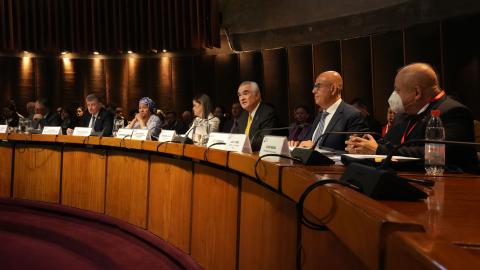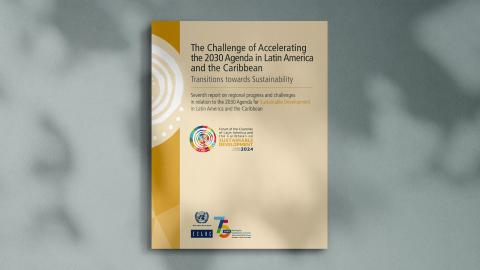Press Release
(13 January 2015) The post-2015 development agenda should not only include gender equality as a specific objective, but also as a cross-cutting perspective to increase women’s economic autonomy. This was agreed upon by representatives of the Governments of Chile and Norway and senior officials from the Economic Commission for Latin America and the Caribbean (ECLAC) at a high-level dialogue held on January 12.
The meeting, which was held at the headquarters of this United Nations Commission in Santiago, Chile, was attended by the Minister of Chile’s National Women’s Service (SERNAM), Claudia Pascual; Norway’s Ambassador in Chile, Hege Araldsen; and Norway’s former Minister of Trade and Industry, Ansgar Gabrielsen. Representing ECLAC were the Director of the Programme Planning and Operations Division, Raúl García-Buchaca, and Director of the Gender Affairs Division, Sonia Montaño.
The dialogue Challenges for equality. Women’s economic autonomy on the post-2015 development agenda: building new responses from Latin America and Europe is part of the debates on the new agenda that will be taking over from the Millennium Development Goals (MDGs) once the period set for achieving them expires this year. In this context, 17 Sustainable Development Goals (SDGs) have been proposed, including one aimed at achieving gender equality and autonomy for all women and girls.
In his address, Raúl García-Buchaca stated “Gender equality and women’s economic autonomy should be at the heart of the development agenda”, adding that almost one in three women (30.8 %) in Latin America does not have her own income. Of these women, 51.6% attribute the situation to having to carry out domestic and care tasks. This results in high poverty rates among women: there are 117 poor women for every 100 men in the same situation.
Chile’s SERNAM Minister, Claudia Pascual, said that the female labour participation rate there was 48.6 % in mid-2014, while the Latin American average according to ECLAC data was 52.8 %, and an average of 63.8 % in countries of the Organisation for Economic Co-operation and Development (OECD). Furthermore, most female workers in Chile are employed in sectors that provide lower quality jobs with less social protection.
According to the Chilean Minister, “The post-2015 agenda faces the challenge not only of ensuring that more women enter the labour market, but also that they join sectors in the economy that have traditionally been male dominated”. She added that access to quality employment was one of the five cornerstones of the gender agenda devised by the Government of President Michelle Bachelet.
Norway’s Ambassador in Chile, Hege Araldsen, agreed that “women’s access to decent jobs, wage equity, equal distribution of domestic tasks, equal rights to property, land and inheritance, and the right to participate fully in politics and the economy are elements that should be priority items on the post-2015 agenda”.
As an example of public policies that promote parity, Norway’s former Minister of Trade and Industry, Ansgar Gabrielsen, described how in 2003 Norway became the first country to impose a gender quota to ensure that 40 % of the board of companies listed on the stock exchange were women. When the law was adopted, female participation at that level was around 7 %.
In this regard, Director of the ECLAC Gender Affairs Division, Sonia Montaño, declared that many Latin American women (even well-educated and affluent ones) cannot enter the labour market because they have to carry out domestic work. This required such work to be shared out equitably, as well as a redistribution of social protection benefits.
She pointed out that unpaid domestic work can account for between 23 % and 36 % of GDP in the region’s countries.


